
Wine Culture and Information since 2002 - Volume 22
 Wine Culture and Information since 2002 - Volume 22 |
|
SangioveseAmong the most common grapes of Italy, Sangiovese is the indisputable king of wines in central Italy where it is virtually present in every area and its fame is such it reached all the wine lovers of the world |
|
Italy is notoriously a country whose ampelographic richness is so vast that every region has its own autochthonous grapes, a patrimony which counts more than 400 different varieties and that in the past few years producers are trying to revaluate like it never happened in the recent enological history of the country. Many of these grapes distinguish Italian wine in the world and have become synonym of high quality wines. Among the representatives of this success there is also Sangiovese, which in its many clonal varieties, continues to prove its indisputable qualities also thanks to the many expressions of the territories in which it is being cultivated. Sangiovese is found in most of the wines from central Italy and it is virtually found in every red wine from Tuscany, Umbria and Marches, most of the times vinified as monovarietal as well as being used, in different percentages, together with the local grapes of every region as well as with international grapes. History tells Sangiovese is among the most ancient Italian grapes of which exist historical witnesses, despite the first mention on a written document is dated back to 1772, it is believed the famous grape was already known 2000 years ago and it was used by Etruscans for the production of wine. Ampelographers believe the place of origin of Sangiovese is Tuscany - where it still represents the most important red berried grape - however it is very common in almost every region of central Italy. This grape is also present in the viticulture of Emilia Romagna, Latium, Liguria, Lombardy, Veneto, Abruzzo, Campania, Molise, Apulia, Calabria, Sicily and Sardinia. Sangiovese has also attracted the attention of producers in other countries - introduced by Italian emigrants - and today are being produced wines with this grape in California, Argentina, Corse and Australia. The name Sangiovese has “mythological” origins, in fact etymologists support the idea it derived from Latin Sanguis Jovis, that is Blood of Jove, and in the course of years it evolved into the current name.
Sangiovese - just like Pinot Noir - has a very high capacity of mutation and today are known tens of clonal varieties belonging to this grape. Conventional ampelography divides Sangiovese into two main categories: Sangiovese Grosso and Sangiovese Piccolo. This division - defined according to ampelographic researches done in the beginning of the 1900's - is based on the size of berries and bunches, however the number of clonal varieties clearly shows this classification is pretty reductive. Of the two main varieties, Sangiovese Grosso is considered to be better and two of its most famous clonal varieties are used for the production of Brunello di Montalcino and Vino Nobile di Montepulciano. In Montalcino the clonal variety of Sangiovese Grosso used for the production of its renowned wine is called Brunello, whereas in Montepulciano, homeland of Vino Nobile, it is called Prugnolo Gentile. The different clonal varieties of Sangiovese are generally defined with specific names which become typical in specific areas. Other terms used for Sangiovese Grosso include Sangiovese Forte and Inganna Cane, whereas for Sangiovese Piccolo are mentioned Cordisco, Morellino, Sangioveto, Sanvicetro, Uva Tosca and Primutico.The relatively simple capacity of mutation of Sangiovese has forced producers to strict clonal selections in order to individuate the best varieties suited for the production of quality wines. Sangiovese - even though this is a characteristic valid for any other grape - makes wines with different qualities, from pretty acid wines with pale colors, to full bodied and alcoholic wines with intense colors. This characteristic is strongly influenced by cultural practices as Sangiovese is a grape which tends to give abundant yields. Sangiovese is a late ripening variety, has a good capacity of adaptation in many types of soils, however it prefers soils with a good percentage of limestone capable of exalting its best and elegant aromas as well as its best qualities. Sangiovese is a pretty sensitive variety to mold, a condition which takes place in pretty cold and wet years or in areas where autumn is particularly rainy. Generally speaking, wines produced with Sangiovese have a pretty high acidity and a high content in tannins, a moderate color and average structure, its tendency to overproduction forces producers to a very scrupulous culture in order to mitigate its impetuosity. One of the most common methods adopted by producers and which allows the mitigation of certain “harsh” aspects of Sangiovese, consists in blending wines produced with other grapes, a role which is traditionally played by Canaiolo Nero, such as for Chianti in Tuscany and Torgiano Rosso in Umbria. Besides Canaiolo Nero, today Sangiovese is frequently blended with Cabernet Sauvignon and Merlot - capable of making the wine smoother as well as increasing its structure - and less frequently, Syrah and other Italian red berried grapes. Sangiovese wines are generally aged in casks - according to the typical tradition of central Italy - however modern enological practices have favored the introduction of barrique which is now very used with wines produced with this grape. Sangiovese is rarely aged in inert containers - such as steel or concrete - because its acidity would be very evident as opposed to the wines aged in wood containers. Even white berried grapes are frequently used with Sangiovese, as in the case of Chianti in which it is allowed the use of Trebbiano Toscano and Malvasia Bianca, even though this practice is less and less used. Because of its high acidity and astringency, Sangiovese is strongly influenced by vintage and the best results are obtained in warm and dry years. Longevity of wines produced with Sangiovese depends on the quality of grapes and on enological practices and it usually goes from 2 to 8 years, however there are cases in which its wines can go beyond 20 years.
|
||||||||
|
The color of wines produced with Sangiovese strongly depends on the way the grapes were cultivated and the meteorological conditions of the year. Sangiovese can be defined as a grape having medium coloring capacities and even in the best examples, despite it may show an intense ruby red color, its transparency is pretty evident. In less favorable years or in particularly abundant yields, transparency in Sangiovese is accentuated and color tends to show pale red hues. It is not rare to see garnet red nuances in young Sangiovese and wines produced with abundant yields tends to show orange hues pretty rapidly. The evolution of colors in wines produced with Sangiovese follows the same course of other red wines. After some years it will be pretty evident a garnet red color as well as showing orange nuances, whereas at the apex of its aging the orange color will be clearly visible in the hue as well.
|
|
The aromas of Sangiovese are mainly oriented to red and black berried fruits of which the main ones are black cherry, blackberry and plum. Among floral aromas violet is the most characteristic one followed by the aroma of rose. Among these aromas the combination which mainly characterizes Sangiovese - despite it is common to other grapes as well - is black cherry and violet. Other aromas of fruit which can be perceived in Sangiovese include black currant, strawberry, cherry, raspberry and blueberry. Sangiovese is usually aged in wood containers - such as casks and barriques - therefore spicy aromas - in particular vanilla and licorice - will be frequent, as well as aromas such as toasted wood, coffee and chocolate. The intensity of these aromas depends on - as always - by the use a producer made of casks or barriques, and it is not rare to find Sangiovese wines in which the strong toasted characters prevails over the typical aromas of the grape. In wines produced with Sangiovese Grosso grape - such as Brunello di Montalcino or Vino Nobile di Montepulciano - because of the longer period of aging before commercialization, aromas of fruit will be replaced by aromas of jams, in particular black cherry jam, plum jam and blackberry jam. In these wines it will be also found an evident hint of vegetal - in particular tobacco - and with time it will also be possible to smell undergrowth, hay and mushrooms. In wines aged in bottle for a long time - both produced with Sangiovese Piccolo and Sangiovese Grosso - it will be possible to perceive appreciable complex aromas and besides aromas of jams it will also be found aromas of leather. Moreover, in Sangiovese it is also possible to appreciate balsamic aromas - such as eucalyptus and menthol - as well as aromatic herbs such as mint and thyme.
|
||||
|
The main gustatory characteristic of Sangiovese is represented by its high acidity, a quality which usually requires proper enological practices in order to make it less aggressive. For this reason wines produced with Sangiovese are being aged in casks - and frequently in barrique - in order to make them rounder. Even the content in tannins of Sangiovese is high and therefore the aging in cask contributes to diminish the natural astringency of these wines. These two characteristics usually justify the choices of some producers - now almost being a common practice - who blend Sangiovese to other grapes in order to mitigate its character. Among the companions of Sangiovese there is Canaiolo Nero, the grape traditionally and historically added to these wines, Cabernet Sauvignon, which gives more structure, and Merlot, capable of smoothing it. The percentage of alcohol is variable from moderate to high, a quality which is appropriate and contributes to the improvement of balance according to acidity and astringency.
|
|
Sangiovese is the most cultivated red berried grape in Italy and it is very common in all the central part. In Tuscany it is virtually present in every red wine and it is the main grape of the most renowned wines of the region. In the most representative wines of Tuscany, such as Chianti, Brunello di Montalcino and Vino Nobile di Montepulciano, Sangiovese is present both as monovarietal and blended with other grapes. Among the historical representatives of the grapes is to be mentioned Chianti, which according to the historical formula defined in 1872 by Baron Bettino Ricasoli, it should have been produced with Sangiovese and Canaiolo Nero. For wines to be consumed young, the formula suggested the use of Malvasia Bianca to which in later times was added Trebbiano Toscano. However, today it is not rare to find Chianti wines produced with Sangiovese only. Brunello di Montalcino, another celebrity of Tuscany, is exclusively produced with Sangiovese Grosso, locally called Brunello. Even Vino Nobile di Montepulciano is produced with Sangiovese Grosso - locally known as Prugnolo Gentile - to which are usually added Canaiolo Nero, Mammolo and Colorino grapes. Countless are the wines in Tuscany produced as IGT with Sangiovese grapes, both as monovarietal as well as blended with other grapes. Even in Umbria Sangiovese plays a fundamental role and it is present in most of red wines of the region. Among the most representative red wines of Umbria and produced with Sangiovese grape, alone or blended, are mentioned Torgiano, Rosso di Montefalco, Colli Amerini, Colli del Trasimeno and Colli Martani. Even in Umbria Sangiovese is virtually present in almost all IGT red wines. In the Marches Sangiovese plays an important role together with Montepulciano: a combination found in Rosso Conero and Rosso Piceno, as well as in other IGT wines. Another interesting and important area for Sangiovese is Emilia Romagna where the grape is used for red wines belonging to the denominations Sangiovese di Romagna, Colli di Faenza and other production belonging to the IGT category. Sangiovese is also cultivated in Latium and marginally in Liguria, Veneto, Lombardy, Abruzzo, Molise, Apulia, Campania, Calabria, Sicily and Sardinia. Outside Italy Sangiovese is cultivated - although in modest quantities - in California in Napa Valley, Sonoma and Sierra Foothills areas, in Argentina at Mendoza, and in Australia. Sangiovese is also cultivated in Corse where it is known as Nielluccio.
|
Wines of the Month |
|
|
|
Score legend Prices are to be considered as indicative. Prices may vary according to the country or the shop where wines are bought |
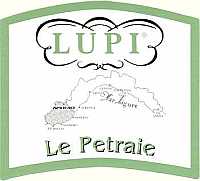
|
|
Riviera Ligure di Ponente Pigato Le Petraie 2003 |
|
| Lupi (Italy) | |
| Grapes: Pigato | |
| Price: € 12,00 | Score: |
| This wine shows a brilliant greenish yellow color and nuances of greenish yellow, very transparent. The nose reveals intense, clean and pleasing aromas which start with hints of apple and hawthorn followed by aromas of peach, broom, pear and plum. In the mouth has good correspondence to the nose, a crisp attack and however balanced by alcohol, good body, intense flavors. The finish is persistent with flavors of apple and plum. | |
| Food Match: Fried fish, Sauteed fish, Pasta and risotto with fish and crustaceans | |
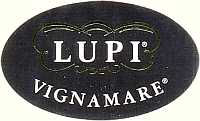
|
|
Vignamare 2000 |
|
| Lupi (Italy) | |
| Grapes: Pigato | |
| Price: € 14,50 | Score: |
| The wine shows a brilliant golden yellow color and nuances of straw yellow, very transparent. The nose denotes intense, clean and pleasing aromas which start with hints of toasted wood, banana and plum followed by aromas of pineapple, hawthorn, broom, apple and hints of smoke. In the mouth has good correspondence to the nose, a crisp attack however well balanced by alcohol, good body, intense flavors, agreeable. The finish is persistent with flavors of apple, plum and banana. Part of this wine ages in barrique. | |
| Food Match: Roasted fish, Fish and mushrooms soups, Roasted white meat, Stuffed pasta | |

|
|
Cent'Anni 2001 |
|
| Sartori (Italy) | |
| Grapes: Corvina (40%), Rondinella (35%), Merlot (25%) | |
| Price: € 25,00 | Score: |
| This wine shows an intense ruby red color and nuances of garnet red, little transparency. The nose reveals intense, clean, pleasing and refined aromas which start with hints of black cherry, raspberry and plum followed by aromas of blueberry, blackberry, dried violet, licorice, tobacco, cinnamon and vanilla. In the mouth has good correspondence to the nose, a slightly tannic attack and however balanced by alcohol, full body, intense flavors, good tannins. The finish is persistent with flavors of blackberry, black cherry and plum. This wine ages for 12 months in barrique followed by 6-9 months of aging in cask. | |
| Food Match: Game, Roasted meat, Braised meat, Hard cheese | |
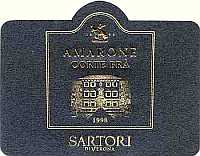
|
|
Amarone della Valpolicella Classico Corte Brà 1998 |
|
| Sartori (Italy) | |
| Grapes: Corvina (50%), Rondinella (40%), Molinara (10%) | |
| Price: € 45,00 | Score: |
| This Amarone shows an intense ruby red color and nuances of garnet red, little transparency. The nose reveals intense, clean, pleasing and refined aromas which start with hints of black cherry and plum followed by aromas of blackberry, dried violet, vanilla, licorice, tobacco, chocolate and hints of menthol. In the mouth has good correspondence to the nose, a slightly tannic attack and however balanced by alcohol, full body, intense flavors, good tannins. The finish is persistent with flavors of blackberry, plum and black cherry. This Amarone ages in cask for 4 years followed by 12 months of aging in barrique and 6 months of aging in bottle. | |
| Food Match: Game, Roasted meat, Braised and stewed meat, Hard cheese | |
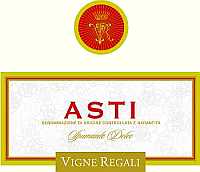
|
|
Asti |
|
| Vigne Regali (Italy) | |
| Grapes: Moscato Bianco | |
| Price: € 6,00 | Score: |
| This Asti shows a brilliant greenish yellow color and nuances of greenish yellow, very transparent, good effervescence, fine and persistent perlage. The nose denotes intense, clean and pleasing aromas which start with hints of grape and peach followed by aromas of broom, banana, litchi and sage. In the mouth has good correspondence to the nose, a sweet, effervescent and crisp attack, however balanced, delicate, intense flavors. The finish is persistent with flavors of grape and peach. | |
| Food Match: Cream desserts, Semifreddo | |
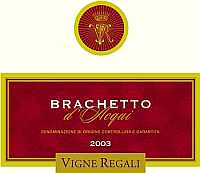
|
|
Brachetto d'Acqui 2003 |
|
| Vigne Regali (Italy) | |
| Grapes: Brachetto | |
| Price: € 8,00 | Score: |
| This wine shows a brilliant ruby red color and nuances of cherry pink, transparent, good effervescence, fine and persistent perlage. The nose reveals clean and pleasing aromas that start with hints of rose and strawberry followed by aromas of raspberry, grape and black cherry. In the mouth has good correspondence to the nose, a sweet, effervescent and crisp attack, however balanced, delicate, intense flavors. The finish is persistent with flavors of grape, strawberry and raspberry. | |
| Food Match: Fruit desserts | |
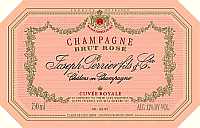
|
|
Champagne Cuvée Royale Brut Rosé |
|
| Joseph Perrier (France) | |
| Grapes: Pinot Noir (75%), Chardonnay (25%) | |
| Price: € 43,00 | Score: |
| This Champagne shows a brilliant salmon pink color and nuances of onion skin pin, transparent, good effervescence, fine and persistent perlage. The nose denotes intense, clean, pleasing and refined aromas which start with hints of raspberry, yeast and tangerine followed by aromas of cherry, banana, strawberry, bread crust and rose. In the mouth has good correspondence to the nose, a crisp and effervescent attack, however balanced, good body, intense flavors, agreeable. The finish is persistent with flavors of tangerine, cherry and raspberry. This Champagne ages in bottle on its lees for 3 years. | |
| Food Match: Pasta and risotto with fish, Broiled fish, Stewed fish, Roasted white meat | |
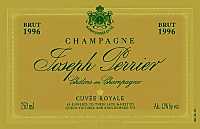
|
|
Champagne Cuvée Royale Millesime 1996 |
|
| Joseph Perrier (France) | |
| Grapes: Pinot Noir (45%), Chardonnay (50%), Pinot Meunier (5%) | |
| Price: € 46,00 | Score: |
| This Champagne shows a brilliant golden yellow color and nuances of golden yellow, very transparent, good effervescence, fine and persistent perlage. The nose reveals good personality with intense, clean, pleasing, refined and elegant aromas which start with hints of praline, baked cake and ripe banana followed by aromas of pineapple, honey, hawthorn, yeast, apple, hazelnut, pear and plum. In the mouth has good correspondence to the nose, a crisp and effervescent attack, however well balanced by alcohol, good body, intense flavors, agreeable roundness. The finish is persistent with flavors of ripe banana, grapefruit and honey. A well made Champagne aged in bottle on its lees for at least 5 years. | |
| Food Match: Roasted fish, White roasted meat, Stewed fish, Broiled crustaceans | |
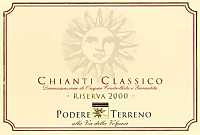
|
|
Chianti Classico Riserva 2000 |
|
| Podere Terreno (Italy) | |
| Grapes: Sangiovese (90%), Canaiolo Nero (10%) | |
| Price: € 16,00 | Score: |
| This Chianti shows an intense ruby red color and nuances of garnet red, moderate transparency. The nose reveals intense, clean and pleasing aromas which start with hints of plum jam and dried violet followed by aromas of black cherry jam, licorice, carob, vanilla, blackberry and hints of menthol. In the mouth has good correspondence to the nose, a slightly tannic attack and however balanced by alcohol, good body, intense flavors, good tannins. The finish is persistent with flavors of plum jam and black cherry jam. This Chianti ages for about 24 months in cask followed by about 6 months in bottle. | |
| Food Match: Roasted meat, Braised and stewed meat, Hard cheese | |
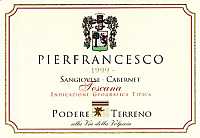
|
|
Pierfrancesco 1999 |
|
| Podere Terreno (Italy) | |
| Grapes: Sangiovese Grosso (90%), Cabernet Sauvignon (10%) | |
| Price: € 17,50 | Score: |
| The wine shows an intense ruby red color and nuances of garnet red, little transparency. The nose reveals intense, clean and pleasing aromas which start with hints of plum, toasted wood and black cherry followed by aromas of blueberry, violet, licorice and eucalyptus. In the mouth has good correspondence to the nose, a slightly tannic attack and however balanced by alcohol, good body, intense flavors, good tannins. The finish is persistent with flavors of plum and black cherry. This wine ages for 12-16 months in barrique followed by about 6 months of aging in bottle. | |
| Food Match: Roasted meat, Braised and stewed meat, Hard cheese | |
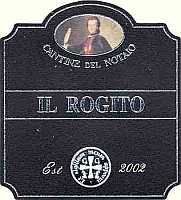
|
|
Il Rogito 2002 |
|
| Cantine del Notaio (Italy) | |
| Grapes: Aglianico | |
| Price: € 14,25 | Score: |
| The wine shows a pale ruby red color and nuances of cherry pink, moderate transparency. The nose denotes intense, clean, pleasing and refined aromas which start with hints of black cherry and raspberry followed by aromas of cyclamen, strawberry, blackberry and hints of vanilla. In the mouth has good correspondence to the nose, a crisp and little tannic attack, however well balanced by alcohol, good body, intense flavors, agreeable. The finish is persistent with flavors of raspberry, strawberry and black cherry. This wine ages for 12 months in cask. | |
| Food Match: Stuffed pasta, Sauteed meat, Roasted fish, Fish soups, Roasted white meat | |
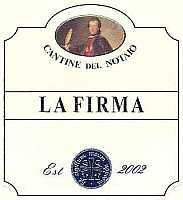
|
|
Aglianico del Vulture La Firma 2002 |
|
| Cantine del Notaio (Italy) | |
| Grapes: Aglianico | |
| Price: € 35,00 | Score: |
| The wine shows an intense ruby red color and nuances of garnet red, little transparency. The nose reveals intense, clean, pleasing, refined and elegant aromas which start with hints of plum and dried violet followed by aromas of black cherry, blueberry, blackberry, vanilla, tobacco, licorice, carob, coriander, eucalyptus and black pepper. In the mouth has good correspondence to the nose, a tannic attack and however well balanced by alcohol, full body, intense flavors, good tannins. The finish is persistent with flavors of plum, blackberry and black cherry. A well made wine. This Aglianico ages in cask for 12 months followed by 4 months of aging in bottle. | |
| Food Match: Braised and stewed meat, Roasted meat, Game, Hard cheese | |
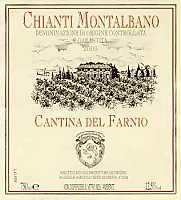
|
|
Chianti Montalbano Cantina del Farnio 2003 |
|
| Betti (Italy) | |
| Grapes: Sangiovese (90%), Cabernet Sauvignon, Canaiolo Nero, Trebbiano Toscano (10%) | |
| Price: € 6,30 | Score: |
| The wine shows a brilliant ruby red color and nuances of ruby red, moderate transparency. The nose denotes intense, clean and pleasing aromas which start with hints of black cherry, raspberry and violet followed by aromas of plum, blueberry and cyclamen. In the mouth has good correspondence to the nose, a slightly tannic and crisp attack however balanced, good body, intense flavors. The finish is persistent with flavors of raspberry and black cherry. This Chianti ages for 6 months in cask and for 2 months in bottle. | |
| Food Match: Broiled meat and barbecue, Stewed meat, Hard cheese | |

|
|
Sangiovese di Romagna Riserva Laurento 2000 |
|
| Umberto Cesari (Italy) | |
| Grapes: Sangiovese Grosso (90%), Cabernet Sauvignon (10%) | |
| Price: € 23,50 | Score: |
| This wine shows an intense ruby red color and nuances of garnet red, moderate transparency. The nose denotes intense, clean, pleasing and refined aromas which start with hints of plum and dried violet followed by aromas of black cherry, blueberry, cyclamen, licorice, carob and vanilla. In the mouth has good correspondence to the nose, a slightly tannic attack and however well balanced by alcohol, good body, intense flavors, good tannins. The finish is persistent with flavors of plum and black cherry. | |
| Food Match: Roasted meat, Broiled meat and barbecue, Braised and stewed meat, Hard cheese | |

|
|
Rosso del Monte 2003 |
|
| Accattoli (Italy) | |
| Grapes: Cabernet Sauvignon (34%), Montepulciano (33%), Pinot Noir (33%) | |
| Price: € 5,76 | Score: |
| This wine shows an intense ruby red color and nuances of ruby red, moderate transparency. The nose reveals intense, clean and pleasing aromas which start with hints of black cherry and plum followed by aromas of blueberry, blackberry and violet. In the mouth has good correspondence to the nose, a slightly tannic attack and however balanced, good body, intense flavors. The finish is persistent with flavors of black cherry and blackberry. This wine ages for 3 months in steel tanks and for 4 months in bottle. | |
| Food Match: Broiled meat, Stewed meat, Roasted meat | |
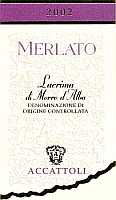
|
|
Lacrima di Morro d'Alba Merlato 2003 |
|
| Accattoli (Italy) | |
| Grapes: Lacrima di Morro d'Alba | |
| Price: € 8,92 | Score: |
| The wine shows a brilliant ruby red color and nuances of purple red, moderate transparency. The nose denotes intense, clean and pleasing aromas which start with hints of cherry and raspberry followed by aromas of blackberry, rose and cyclamen. In the mouth has good correspondence to the nose, a slightly tannic attack and pleasing crispness, however balanced, good body, intense flavors. The finish is persistent with flavors of cherry and raspberry. This wine ages i steel tanks for 5 months. | |
| Food Match: Pasta with meat, Sauteed meat, Roasted white meat | |
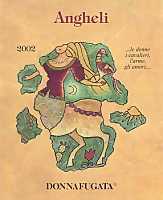
|
|
Angheli 2002 |
|
| Donnafugata (Italy) | |
| Grapes: Nero d'Avola (50%), Merlot (50%) | |
| Price: € 14,20 | Score: |
| This wine shows an intense ruby red color and nuances of garnet red, little transparency. The nose reveals intense, clean, pleasing, refined and elegant aromas that start with hints of plum, black cherry and dried violet followed by aromas of blueberry, blackberry, vanilla, licorice, tobacco, cocoa, mace and menthol. In the mouth has good correspondence to the nose, a slightly tannic attack and however balanced by alcohol, good body, intense flavors, good tannins. The finish is persistent with flavors of blackberry, plum and black cherry. A well made wine. Angheli ages for 12 months in barrique followed by at least 4 months of aging in bottle. | |
| Food Match: Stewed and braised meat with mushrooms, Roasted meat, Hard cheese | |
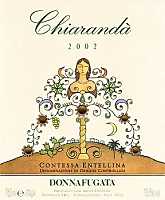
|
|
Contessa Entellina Chiarandà 2002 |
|
| Donnafugata (Italy) | |
| Grapes: Chardonnay (50%), Ansonica (50%) | |
| Price: € 20,20 | Score: |
| This wine shows a pale golden yellow color and nuances of straw yellow, very transparent. The nose reveals intense, clean and pleasing aromas which start with hints of plum and vanilla followed by aromas of banana, hawthorn, toffee, orange, almond, quince jam, apple, honey and ripe peach. In the mouth has good correspondence to the nose, a crisp attack and however well balanced by alcohol, good body, intense flavors, agreeable. The finish is persistent with flavors of apple, plum and almond. A well made wine. Chiarandà ages for 6 months in barrique followed by at least 6 months of aging in bottle. | |
| Food Match: Roasted fish, Stuffed pasta with mushrooms, Roasted white meat, Stewed fish | |
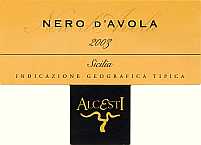
|
|
Nero d'Avola 2003 |
|
| Alcesti (Italy) | |
| Grapes: Nero d'Avola | |
| Price: € 10,00 | Score: |
| This wine shows a brilliant ruby red color and nuances of ruby red, moderate transparency. The nose reveals intense, clean and pleasing aromas which start with hints of plum and blackberry followed by aromas of black cherry, blueberry, violet, carob and licorice. In the mouth has good correspondence to the nose, a slightly tannic attack and however balanced by alcohol, good body, intense flavors. The finish is persistent with flavors of plum and black cherry. This Nero d'Avola ages in barrique for 6 months. | |
| Food Match: Roasted meat, Stewed meat, Hard cheese | |
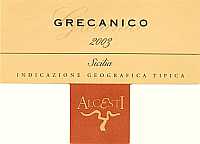
|
|
Grecanico 2003 |
|
| Alcesti (Italy) | |
| Grapes: Grecanico | |
| Price: € 8,00 | Score: |
| This wine shows a pale straw yellow color and nuances of greenish yellow, very transparent. The nose reveals intense, clean and pleasing aromas which start with hints of pear and hawthorn followed by aromas of peach, apple, broom and plum. In the mouth has good correspondence to the nose, a crisp attack and however balanced by alcohol, good body, intense flavors. The finish is persistent with flavors of apple, pear and plum. This wine ages for 6 months in steel tanks. | |
| Food Match: Fried fish, Sauteed fish, Pasta and risotto with fish | |
|
||||||||
|
DiWineTaste Polls
|
| |||||||
Privacy Policy | |||||||


| Copyright © 2002-2024 Antonello Biancalana, DiWineTaste - All rights reserved |
| All rights reserved under international copyright conventions. No part of this publication and of this WEB site may be
reproduced or utilized in any form or by any means, electronic or mechanical, without permission in writing from DiWineTaste. |